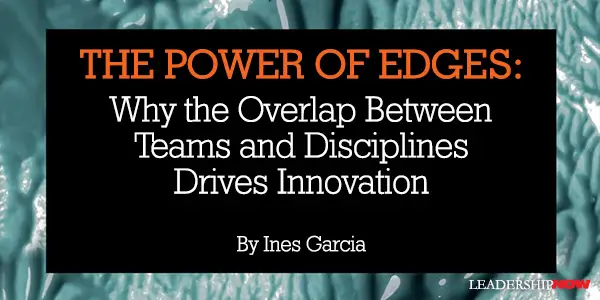 |
 |
11.12.25

The Power of Edges: Why the Overlap Between Teams and Disciplines Drives Innovation
THE most biodiverse place on Earth isn’t found deep in the Amazon rainforest or in the heart of the ocean. It’s at the edges–where forest meets water, where mountain slopes transition to valley floors, where different ecosystems intersect and create something neither could achieve alone. These “edge effects” generate extraordinary abundance through the dynamic interaction of different systems. The same principle applies to our organizations, yet most businesses are designed to minimize exactly these kinds of productive intersections. We organize into departments, create clear reporting lines, and establish distinct territories of responsibility. While this structure provides clarity, it also eliminates the spaces where innovation most naturally occurs. Picture your organization’s structure as a diagram. It likely shows neat boxes connected by clean lines: marketing here, engineering there, sales over here. These artificial boundaries create “innovation dead zones” where potentially transformative interactions simply never happen. When teams operate exclusively within their designated boxes, customer problems get bounced between departments, resources get duplicated, and breakthrough solutions remain undiscovered. The cumulative effect drains organizational energy. Instead of generating value, rigid boundaries create tension points where good work goes to die. Three Strategies to Harness Your Organization’s Edge Effects
Companies that master edge effects consistently outperform their competitors. 3 M’s innovation pipeline thrived because they’ve institutionalized cross-pollination; their famous Post-it Notes emerged from the intersection of adhesive technology and office products. Commonly referred Toyota, they achieved higher quality and faster improvement cycles than competitors because they’ve eliminated rigid departmental separations in favor of integrated problem-solving. These organizations recognize that their greatest untapped resource isn’t hidden within existing departments—it’s waiting to emerge in the spaces between them. Inspect & Adapt It’s worth mentioning that common metrics often miss the value created at organizational edges because they’re designed to measure individual departmental performance. Organizations serious about edge effects need new approaches: track communication patterns across boundaries, identify which breakthrough ideas emerged from cross-functional collaboration, measure customer experience across entire journeys rather than individual touchpoints, and survey how energized employees feel when working on cross-functional versus departmental projects. “The future is not to be predicted nor forecasted but firstly imagined so that it can be created.” As customer expectations span multiple disciplines, as technology blurs industry boundaries, and as global challenges require integrated solutions, organizational edges become competitive advantages. The companies that will thrive in an increasingly complex world won’t be those with the most efficient departments; they’ll be those with the most productive intersections. REvolution The evolution begins with recognizing that the spaces in between on your organizational chart items aren’t empty space to be ignored–it’s innovation space to be cultivated. Nature has spent billions of years demonstrating that abundance flourishes at edges. Organizations ready to learn from this fine-tuned R&D will discover their greatest opportunities in the spaces we have been overlooking all along.  
Posted by Michael McKinney at 08:17 AM
|
BUILD YOUR KNOWLEDGE
 

How to Do Your Start-Up Right STRAIGHT TALK FOR START-UPS 
Grow Your Leadership Skills NEW AND UPCOMING LEADERSHIP BOOKS 
Leadership Minute BITE-SIZE CONCEPTS YOU CAN CHEW ON 
Classic Leadership Books BOOKS TO READ BEFORE YOU LEAD |